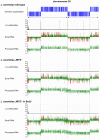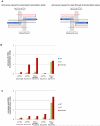Glucosylated hydroxymethyluracil, DNA base J, prevents transcriptional readthrough in Leishmania
- PMID: 22939620
- PMCID: PMC3684241
- DOI: 10.1016/j.cell.2012.07.030
Glucosylated hydroxymethyluracil, DNA base J, prevents transcriptional readthrough in Leishmania
Abstract
Some Ts in nuclear DNA of trypanosomes and Leishmania are hydroxylated and glucosylated to yield base J (β-D-glucosyl-hydroxymethyluracil). In Leishmania, about 99% of J is located in telomeric repeats. We show here that most of the remaining J is located at chromosome-internal RNA polymerase II termination sites. This internal J and telomeric J can be reduced by a knockout of J-binding protein 2 (JBP2), an enzyme involved in the first step of J biosynthesis. J levels are further reduced by growing Leishmania JBP2 knockout cells in BrdU-containing medium, resulting in cell death. The loss of internal J in JBP2 knockout cells is accompanied by massive readthrough at RNA polymerase II termination sites. The readthrough varies between transcription units but may extend over 100 kb. We conclude that J is required for proper transcription termination and infer that the absence of internal J kills Leishmania by massive readthrough of transcriptional stops.
Copyright © 2012 Elsevier Inc. All rights reserved.
Figures






Similar articles
-
Identification of a novel base J binding protein complex involved in RNA polymerase II transcription termination in trypanosomes.PLoS Genet. 2020 Feb 21;16(2):e1008390. doi: 10.1371/journal.pgen.1008390. eCollection 2020 Feb. PLoS Genet. 2020. PMID: 32084124 Free PMC article.
-
Defining the sequence requirements for the positioning of base J in DNA using SMRT sequencing.Nucleic Acids Res. 2015 Feb 27;43(4):2102-15. doi: 10.1093/nar/gkv095. Epub 2015 Feb 6. Nucleic Acids Res. 2015. PMID: 25662217 Free PMC article.
-
Regulation of transcription termination by glucosylated hydroxymethyluracil, base J, in Leishmania major and Trypanosoma brucei.Nucleic Acids Res. 2014 Sep;42(15):9717-29. doi: 10.1093/nar/gku714. Epub 2014 Aug 7. Nucleic Acids Res. 2014. PMID: 25104019 Free PMC article.
-
beta-D-glucosyl-hydroxymethyluracil, a novel base in African trypanosomes and other Kinetoplastida.Mol Biochem Parasitol. 1997 Dec 1;90(1):1-8. doi: 10.1016/s0166-6851(97)00170-9. Mol Biochem Parasitol. 1997. PMID: 9497027 Review.
-
Base J: discovery, biosynthesis, and possible functions.Annu Rev Microbiol. 2008;62:235-51. doi: 10.1146/annurev.micro.62.081307.162750. Annu Rev Microbiol. 2008. PMID: 18729733 Review.
Cited by
-
Molecular basis for 5-carboxycytosine recognition by RNA polymerase II elongation complex.Nature. 2015 Jul 30;523(7562):621-5. doi: 10.1038/nature14482. Epub 2015 Jun 29. Nature. 2015. PMID: 26123024 Free PMC article.
-
New functions for DNA modifications by TET-JBP.Nat Struct Mol Biol. 2012 Nov;19(11):1061-4. doi: 10.1038/nsmb.2437. Nat Struct Mol Biol. 2012. PMID: 23132381 Free PMC article.
-
TETonic shift: biological roles of TET proteins in DNA demethylation and transcription.Nat Rev Mol Cell Biol. 2013 Jun;14(6):341-56. doi: 10.1038/nrm3589. Nat Rev Mol Cell Biol. 2013. PMID: 23698584 Free PMC article. Review.
-
J-binding protein 1 and J-binding protein 2 expression in clinical Leishmania major no response-antimonial isolates.J Parasit Dis. 2019 Mar;43(1):39-45. doi: 10.1007/s12639-018-1052-5. Epub 2018 Nov 20. J Parasit Dis. 2019. PMID: 30956444 Free PMC article.
-
Identification of a novel base J binding protein complex involved in RNA polymerase II transcription termination in trypanosomes.PLoS Genet. 2020 Feb 21;16(2):e1008390. doi: 10.1371/journal.pgen.1008390. eCollection 2020 Feb. PLoS Genet. 2020. PMID: 32084124 Free PMC article.
References
-
- Agabian N. Trans splicing of nuclear pre-mRNAs. Cell. 1990;61:1157–1160. - PubMed
-
- Armour CD, Castle JC, Chen R, Babak T, Loerch P, Jackson S, Shah JK, Dey J, Rohl CA, Johnson JM, Raymond CK. Digital transcriptome profiling using selective hexamer priming for cDNA synthesis. Nat. Methods. 2009;6:647–649. - PubMed
-
- Beisel C, Paro R. Silencing chromatin: comparing modes and mechanisms. Nat. Rev. Genet. 2011;12:123–135. - PubMed
-
- Belli SI, Monnerat S, Schaff C, Masina S, Noll T, Myler PJ, Stuart K, Fasel N. Sense and antisense transcripts in the histone H1 (HIS-1) locus of Leishmania major. Int. J. Parasitol. 2003;33:965–975. - PubMed
-
- Berriman M, Ghedin E, Hertz-Fowler C, Blandin G, Renauld H, Bartholomeu DC, Lennard NJ, Caler E, Hamlin NE, Haas B, et al. The genome of the African trypanosome Trypanosoma brucei. Science. 2005;309:416–422. - PubMed
Publication types
MeSH terms
Substances
Associated data
- Actions
Grants and funding
LinkOut - more resources
Full Text Sources
Other Literature Sources
Molecular Biology Databases

